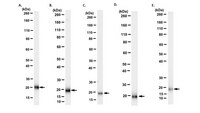Mammalian target of rapamycin complex I (mTORC1) activity in ras homologue enriched in brain (Rheb)-deficient mouse embryonic fibroblasts.
Groenewoud, MJ; Goorden, SM; Kassies, J; Pellis-van Berkel, W; Lamb, RF; Elgersma, Y; Zwartkruis, FJ
PLoS One
8
e81649
2013
概要を表示する
The Ras-like GTPase Rheb has been identified as a crucial activator of mTORC1. Activation most likely requires a direct interaction between Rheb and mTOR, but the exact mechanism remains unclear. Using a panel of Rheb-deficient mouse embryonic fibroblasts (MEFs), we show that Rheb is indeed essential for the rapid increase of mTORC1 activity following stimulation with insulin or amino acids. However, mTORC1 activity is less severely reduced in Rheb-deficient MEFs in the continuous presence of serum or upon stimulation with serum. This remaining mTORC1 activity is blocked by depleting the cells for amino acids or imposing energy stress. In addition, MEK inhibitors and the RSK-inhibitor BI-D1870 interfere in mTORC1 activity, suggesting that RSK acts as a bypass for Rheb in activating mTORC1. Finally, we show that this rapamycin-sensitive, Rheb-independent mTORC1 activity is important for cell cycle progression. In conclusion, whereas rapid adaptation in mTORC1 activity requires Rheb, a second Rheb-independent activation mechanism exists that contributes to cell cycle progression. | 24303063
 |
A MAP4 kinase related to Ste20 is a nutrient-sensitive regulator of mTOR signalling.
Findlay, GM; Yan, L; Procter, J; Mieulet, V; Lamb, RF
Biochem J
403
13-20
2007
概要を表示する
The mTOR (mammalian target of rapamycin) signalling pathway is a key regulator of cell growth and is controlled by growth factors and nutrients such as amino acids. Although signalling pathways from growth factor receptors to mTOR have been elucidated, the pathways mediating signalling by nutrients are poorly characterized. Through a screen for protein kinases active in the mTOR signalling pathway in Drosophila we have identified a Ste20 family member (MAP4K3) that is required for maximal S6K (S6 kinase)/4E-BP1 [eIF4E (eukaryotic initiation factor 4E)-binding protein 1] phosphorylation and regulates cell growth. Importantly, MAP4K3 activity is regulated by amino acids, but not the growth factor insulin and is not regulated by the mTORC1 inhibitor rapamycin. Our results therefore suggest a model whereby nutrients signal to mTORC1 via activation of MAP4K3. | 17253963
 |









